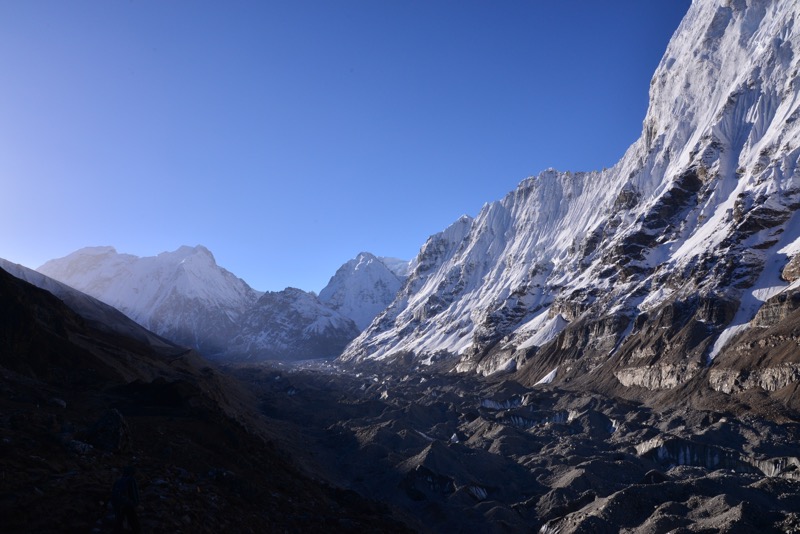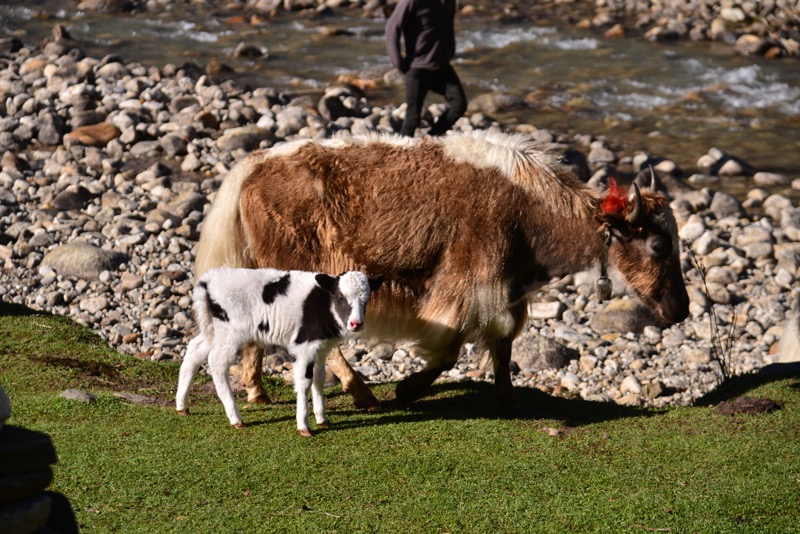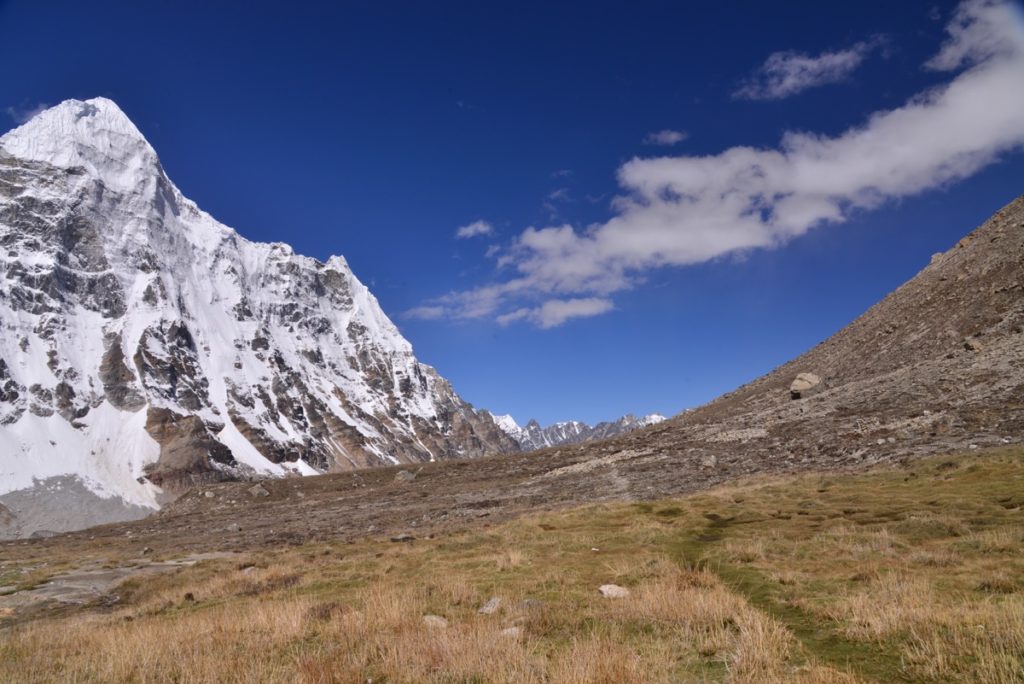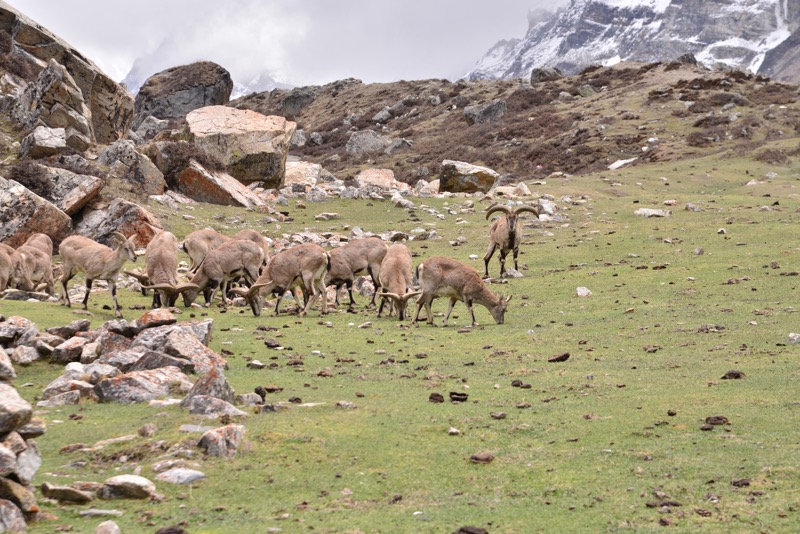Kanchenjunga Circuit At Glance
[table id=2 /]
Know When To Trek Kanchenjunga Circuit

There are actually 6 seasons in Nepal! But on the whole, there are 4 main ones winter, spring, monsoon and autumn. With every season the trails and conditions change. So pick your time wisely!
Winter and monsoon have a massive impact on this region. In the winter passes are blocked, snow is deep and most, if not all, teahouses will be closed. In the monsoon trails are slippery and there are higher chances of landslides.
The best times to trek? October, November, April and May.
Recommendation: I did this trek in May but my recommendation is to trek the Kanchenjunga Circuit in November when the skies are clear, it is not too hot at lower elevations yet not too cold at higher elevations. It’s the time when all the tea houses are open and you get the best possible views!
Clockwise Circuit Itinerary Is Better

Unlike the Manaslu Circuit, Kanchenjunga is doable both clockwise and anti-clockwise.
However, the clockwise itinerary is better than anti-clockwise. Why? Because of acclimatization. When you travel clockwise there are two acclimatization days which are recommended to so as to avoid any altitude related problems.
If you travel anti-clockwise there is a 2000 m+ ascent on the 4th day as well as long and difficult passes to cross with limited acclimatization.
Recommendation: Go clockwise.
Here is my itinerary which you might want to follow.
You Cannot Trek Kanchenjunga Solo Or Independently

One of the hot topics in debate is whether you should trek in Nepal independently or with a trekking agency. However, unlike some routes which can be done independently, you CANNOT trek Kanchenjunga independently. Why? Because this is a restricted area and you need a special restricted area permit. Having a guide is mandatory. The rules also state there needs to be at least two trekkers, but there is a loophole to this rule and a ‘ghost’ permit may be possible to arrange.
Pros of organized trek:
- Everything is organized for you.
- Experienced local guide and porters with local knowledge.
- You can enjoy your trek carrying only a day backpack while the rest is carried by a porter.
- This helps support the local economy.
Cons of organized trek:
- Expensive!
- Have to stick to the plan! No chance to take an extra day to rest your tired legs or explore a particular area more fully. And group personalities! When tired and at altitude ‘personalities’ come out!
Recommendation: If you are already in a group of two or more keep your trek private just your own group. This enables you to be flexible and you know who you are going to spending the next 2 or 3 weeks with!
You Need To Be Fit

Trekking Kanchenjunga is not a marathon but you need to be fit.
Having said that, the majority of days are short and manageable with a couple of long days of over 7 hours. But as you are walking at altitude, even short distances take more energy and time. And let’s not forget what is considered ‘flat’ in the Nepal mountains includes going up and down, and up and down, and …
Recommendation: Build your general cardio fitness at least a month before coming to Nepal. Building your thigh and calf muscles will also help. And don’t forget to test and wear your hiking boots. Even the fittest trekker will be slowed down by a case of bad blisters!
You Need Two Permits For Kanchenjunga
You need two permits for trekking Kanchenjunga. These will set you back USD 65.
- One is for entry to the Kanchenjunga Conservation Area USD 25
- The other is for the restricted area entry permit for Kanchenjunga at USD 20 per week, or USD 40 for 2 weeks.
Permits will be checked at different check posts along the trail!
Whoever you choose as your trekking company – operator will ensure you are issued with the correct permits (no photo required) and your guide will ensure your smooth passage through the check posts.
It’s Long And Tough

The Kanchenjunga Circuit Trek is long. And it’s tough.
Some days are physically exhausting, which is increased by the lack of food varieties and the basic nature of the accommodation. And there is a long drive at the beginning of the trek which is also exhausting under the road conditions in Nepal.
You should be prepared for all of this. This is no ‘apple pie’ trek! Oh, and yes, there is no internet so you will have to wait to share your photos of your hardships and joys!
The Scenery Is Incredible

In order to make up for No. 12 above, nature has ensured every single day in Kanchenjunga has incredible scenery!
It’s a remote and wild area, with glaciers and rocky paths, rolling clouds, stunning mountains and smiling locals! Some of the mountains you will see are Jannu Peak, Kanchenjunga, Wedge Peak, Rathong, and Bokta Peak, making all that hardship worthwhile!
Altitude Sickness Exists
Altitude can affect anyone. There is no definition as to who is more likely to be susceptible to altitude related illness. Even the fittest athlete alive can suffer from altitude.
It is best to take altitude seriously and take precautions at anything over 3000 m. The general advice is go slow and keep hydrated. Those of you who are super fit need to slow down. It’s not a race!
On the clockwise route you need to start paying attention to your health from Ghunsa Village onwards. Always follow the rules to avoid Acute Mountain Sickness.
Accommodation Is Pretty Poor

Don’t keep your expectations too high! If you are expecting Sheraton or Marriott Hotel style accommodation on this route, you will surely be disappointed.
Accommodation is quite decent in the lower parts of the trek but as your go higher there is limited and more basic accommodation. There is even only one place to stay at Pang Pema, Sele Le and Ramche. If there is a bathroom (and some do not have toilets!), expect your shower to come in a bucket.
The food is expensive, as this is how teahouses make their money. Yet the food, while plentiful and filling, will become boring as the menu will be similar everywhere. This is where bringing your own supply of chocolate and snacks comes in!
Take Only What You Need

I have seen people carrying too much kit as well as people carrying too little.
Please note that having a porter doesn’t mean you can bring all your belongings. He has a weight limit too! And do you really need that ‘good shirt’? You can leave what you will not need back in Kathmandu at your hotel or your tour operators office.
Recommendation: Keep your kit down to 10kg.
Have A Medical Kit For The Unexpected
While most operators provide a medical kit to each kit I still recommend you bring your own. It can save your life! And don’t forget to bring a supply of any regular medicines you take, with a few days extra.
Prepare For 4 Seasons In One Trek
With 91 m elevation at Bhadrapur and 5200 m elevation at Pang Pema (North Base Camp) finding a balance with clothing is tricky. The Kanchenjunga circuit trek ranges from the tropical to the alpine in terms of climate.
Until you reach Ghunsa you may be wondering why you are carrying warm clothing. But once you reach Ghunsa then you will realize! Some days you will walk in shorts and t shirt with temperatures above 25 degree Celsius. Other days you will be wearing everything you have in – 10 degrees!
It’s Expensive But Totally Worth It!

With mandatory guide, expensive domestic flights and long number of days Kanchenjunga seems more expensive than other treks. With all in packages it should start from at least USD 2000 per person.
Yet with all the incredible scenery, and the fact you are unlikely to meet any other trekkers on this route, this money is very well spent!
With regards to your personal money there are no ATMs (except at Bhadrapur) and no one will accept cards or foreign currency. So carry enough Nepali rupees in cash to cover any costs you think you might have. That (make it a special, rare treat not a daily thing please) glass of beer or handicraft you might want to buy needs to be paid for in local currency.
Tipping Is Expected
The culture of tipping isn’t a thing in Nepal. So it is not compulsory.
BUT, trekking guides and porters do rely on supplementing their income with tips and do expect it. Why? Because being a tourist guide and porter is only a seasonal job in Nepal, with no or little work the rest of the year. And, blame those tourists who came before who were used to tipping in their own country and started the culture here! But seriously, it is expected and well appreciated.
- The standard for tipping a guide is *USD 10-12 per day
- The standard for tipping a porter is *USD 8-10 per day
*per group, not per trekker within the group
You Need Travel Insurance
Don’t ever leave for an adventure trip like Kanchenjunga without travel insurance. Period!
We never know what we will encounter on such trips altitude sickness, physical injuries or natural disaster. The unexpected can happen so we need to be prepared. Even a simple twisted ankle can turn into a major disability if you are half way through a long trek.
Recommendation: World Nomads for your insurance.
Respect The Culture
Kanchenjunga is considered as a holy mountain by the locals so please show respect for the local’s beliefs.

How? Dress appropriately (probably not a problem at the colder high altitudes but bear this in mind at lower altitudes where it is warmer and in the teahouses). Pass on the right hand side (clockwise) if you see any stupa, prayer wheels or prayer flags.
Leave It Unspoiled – Take Your Rubbish Out!
There is no proper and adequate disposal options in the mountains. Burn it or bury it is the old phrase that comes to mind. But these days we do not recommend this anymore.
Better to be a responsible trekker by having reusable gear where possible and bringing your own tote bag to take your own rubbish out of the mountain area. It’s likely you will not have a lot of rubbish anyway, but bring out chocolate wrappers, used batteries and the like.
Bring A Satellite Communication Device
You don’t need a proper satellite phone but a simple communication device if good enough if it can message or email.
Recommendation: I personally used Delorme Inreach Explorer which means I am always trackable to friends and family. With this you can also check the weather forecast and seek help when there is no phone signal or internet.
There Are Two Base Camps On The Kanchenjunga Circuit
With five distinct summits of the Kanchenjunga Range, you will visit two base camps on the circuit trek.

You can choose and do them individually north or south base camp depending on your chose of itinerary and number of days. But with just the addition of 5 more days you can do the circuit trek and visit Kanchenjunga North and South Base Camps.
Which I highly recommend, as why not get the most from your once in a lifetime trip to Kanchenjunga!
